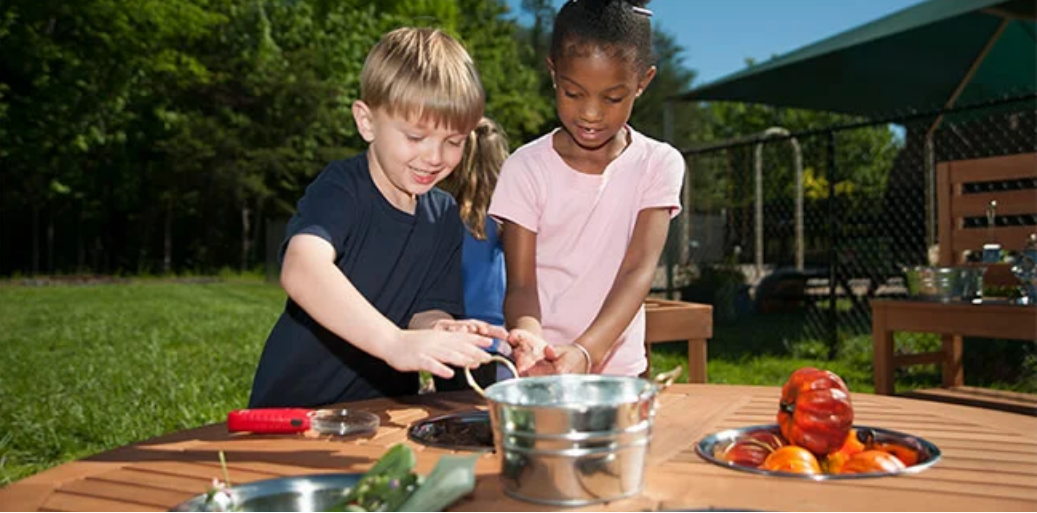With summer here and the temperatures allowing for grand outdoor adventures, we are ready for the captivating realm of outdoor sensory play for preschoolers! Don’t you just love the sheer delight of your little ones immersing themselves in a world of sensory exploration with laughter echoing through the air? This season is an endless opportunity for both learning and pure fun!
At this stage of early childhood, the development of the five senses is a pivotal milestone. Sight, hearing, taste, smell, and touch all play a vital role in shaping a child’s understanding of the world. That’s why we believe that outdoor play, with its abundance of sensory stimuli, can enhance their growth and learning experiences. In this post, we will dig into some fun activities that engage all of the senses while incorporating learning into outdoor playtime.
The Five Senses and Their Development in Preschoolers
Preschoolers’ are at such a fun age to watch and explore their surroundings. Everything still has that sense of newness and excitement that makes every day an exciting adventure while they begin to understand their senses and get a feel for how they impact their days. Here is a little insight into the five senses and how they develop in preschoolers.
Sight
Through their eyes, preschoolers observe vibrant colors, fascinating shapes, and captivating movements in their surroundings. Visual stimulation plays a key role in their cognitive and perceptual development, which is why most animated films and TV shows are so bright and lively. By taking the screens away and getting the kiddos outside, they can be stimulated by a whole world of colors and brightness that they will learn to interact with.
Hearing
The world is filled with a symphony of sounds just waiting to be discovered. From the chirping of birds to the rustling of leaves, preschoolers’ growing auditory abilities allow them to detect and distinguish various sounds, fostering their language development and auditory processing skills.
Taste
Oh, the delightful world of flavors! This may come as surprising, but preschoolers’ taste buds are constantly seeking new culinary experiences. Experiencing different tastes not only introduces them to diverse foods but also stimulates their sense of taste, helping them develop preferences and an awareness of different flavors, which can greatly assist with picky eating and perhaps help to avoid it altogether.
Smell
The air carries a bouquet of scents, each with its own story to tell. Preschoolers’ olfactory senses are finely attuned to the world around them. Whether it’s the aroma of freshly baked cookies or the fragrance of blooming flowers, their sense of smell aids in memory formation and emotional connections.
Touch
Our skin is a gateway to discovery, and preschoolers are eager pioneers. Their sense of touch allows them to feel various textures, temperatures, and sensations, enabling them to understand their environment better and refine their fine motor skills. They may also find some sensations especially comforting such as a specific toy or blanket they favor.
Importance of Sensory Development During The Preschool Years
Engaging the senses through purposeful play and exploration lays the foundation for various cognitive, social, and physical skills. These years are critical in sensory development, where you will start to see changes in a few key areas.
Cognitive Development: You will start to see your child developing cognitive skills such as problem-solving, critical thinking and spatial awareness. Sensory experiences really help this process by providing valuable input to a child’s brain, helping them make connections, form memories, and develop cognitive skills.
Language Development: Sensory-rich experiences stimulate language development as children encounter new sights, sounds, tastes, smells, and textures. Describing and discussing sensory experiences build their vocabulary and ability to express themselves. After taking a nature walk or just exploring the back yard, ask questions about what they’ve seen and heard to work on expanding that knowledge!
Emotional and Social Development: Sensory play can evoke a range of emotions and contribute to the development of emotional intelligence. It also offers opportunities for social interaction, cooperation, and empathy as children engage in shared sensory experiences.
Physical Development: Sensory play encourages the refinement of fine and gross motor skills. Whether it’s manipulating objects, navigating uneven terrain, or engaging in physical activities, the senses play a crucial role in developing coordination, balance, and body awareness. It can be so fun to help your child walk across a fallen log and see the look of achievement on their face when they’ve made it across!
By understanding the significance of sensory development during the preschool years, we can embrace outdoor sensory play as a powerful tool for supporting our little ones’ growth and providing them with a solid foundation for future learning adventures.
Our senses give us important information thousands of times each day. Children use their senses to learn about and explore the world around them. Providing kids with sensory play opportunities every day offers many great benefits. For a child with autism, sensory processing disorder (SPD), or attention deficit hyperactivity disorder (ADHD), meeting sensory needs supports cognitive development, improves emotional regulation, and increases brain function. Simply put, engaging the senses through play helps children learn and grow. For any child, regardless of an autism diagnosis, sensory activities help them learn essential skills like:
- Grasping Small Items (fine motor skills)
- Balancing and Walking (gross motor skills)
- Developing Knowledge (cognitive skills)
- Reasoning and Planning (problem-solving skills)
- Collaboration (social skills)
- Learning New Words (language skills)
- Expressing Emotions (emotional regulation skills)
The Benefits of Playing Outside
Playing outdoors is a crucial activity for the growth of healthy children. Regular outdoor play can:
- Improve physical health
- Aid in better sleep
- Build an ability to assess risk and make safe choices
- Encourage a love for science and nature
- Develop new social skills
- Lead to better learning outcomes
1. Make the Most of Playtime
Outdoor sensory activities build a foundation for a healthier, happier child with new skills to help them thrive. Here are some ideas for you, your children, and your whole family to reap all the benefits of sensory play outside this summer!
1. In the Backyard or at Home
- Plant a garden
Plant wildflowers or an edible garden and bring your children along for the journey. Not only is the experience educational, but digging in the dirt, watering flowers, and taste-testing yummy fruits and vegetables make for great sensory activities. - Roll down a hill
Get over those pesky grass stains because rolling down a hill is a fun sensory activity. The spinning and rotating result in Vestibular Input, a type of movement that causes the fluid of the inner ear to flow and hit important sensory receptors. - Run through a sprinkler
Grab a sprinkler and let the kids run wild! Jumping through and running away from the sprays of water is a great sensory activity that can help cool them down in the hot summer months. - Get creative with water painting
For a calmer water activity, let the creativity flow with water paints. Fill a bucket or bin with water and several paintbrushes of various sizes, and let your children “paint” the driveway, sidewalk, or porch. Let the sun dry their canvases, and they can repeat the activity over and over.
2. At the Playground or Park
- Find a sensory playground
Many playgrounds are built to meet children’s important sensory needs. Look for special playgrounds and structures that allow for swinging, jumping, balancing, music, and nature exploration for a sensory-filled visit! - Hang from the monkey bars
Most playgrounds and parks have monkey bars or something similar for children to play on. The hard grip and swinging required to traverse the bars are important activities that help improve hand strength and coordination. - Play on the swing set
Swinging is an important sensory activity for children with autism or other sensory processing disorders. Using different kinds of swings in outdoor play not only helps calm children but also helps them engage in movements that strengthen various skills, such as coordination, balance, and body awareness. - Walk along the beams
Utilize balance beams or the border around a sandbox or play area to help your child practice balance and coordination. If your child is older, you could make the activity more fun by pretending the ground is lava. Challenge them to get from one point to another without falling.
3. At the Beach or Lake
- Walk in the Sand
Walk with your child at the beach and sink your toes into the sand. Talk about what it feels like to do this on dry sand and wet sand. - Play buried treasure
Bury sand toys or rocks in the sand and pretend it’s buried treasure. This is a great way to engage your child in sensory play that meets their Proprioceptive Input needs. Proprioception is sensory input children sense in their joints and muscles that tell them where their body is and how it is moving. Beach activities like digging in and carrying sand are great examples of this. - Play beach mummy
Bury your child’s legs and or torso under the sand. The pressure and weight of the sand offer a unique proprioceptive input to help your child learn and develop. For added fun, see if they can be a beach mummy and rise up by pushing through the sand. - Jump over waves
Have fun running toward the waves and jumping over them, or challenge your child to run from the waves and rash back to shore. This is a fun activity to stimulate your child’s senses.
4. On a Walk or Hike
- Do a sensory scavenger hunt
Explore the outdoors using all 5 senses! Whether you’re out on a neighborhood walk or hiking in the woods, kids will have a blast searching for items on their scavenger hunt list. - Climb a tree
Climbing is an important sensory activity for children of all ages. The pressure in their muscles and joints while climbing helps with internal regulation. Also, the touch of tree bark, branches, and leaves adds an extra layer of tactile sensory fun! - Collect items for a tactile outdoor sensory activities bin
Help your children build an inventory of sensory items to store and explore when they are outside. While on a walk or a hike, gather flowers, sticks, leaves, acorns, rocks, and other items your kids can use to play with at home. - Do an animal parade
While on a walk or hike, pretend you’re leading your own parade. Have your kids walk and move like the animal you name. The differences between animal actions like breezy monkey swings, big elephant stomps, and a playful penguin waddle all result in helpful sensory movements.

